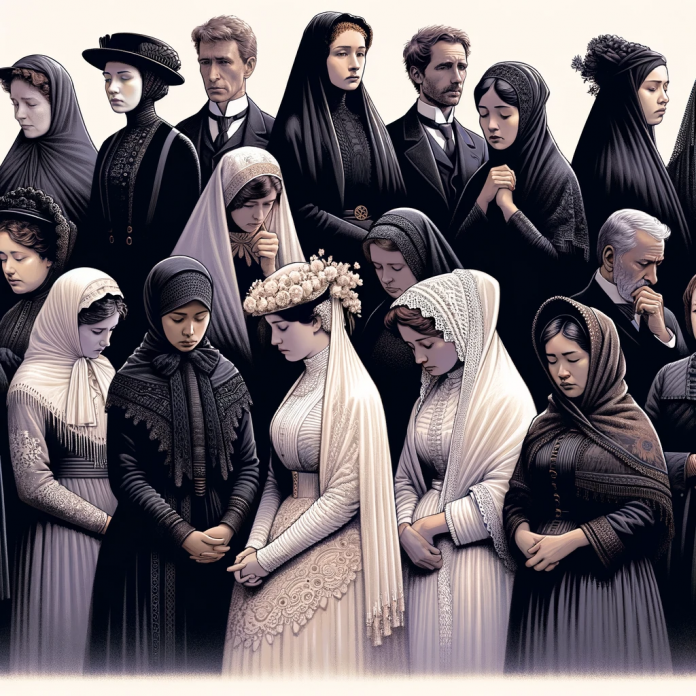Mourning clothes, the attire worn during periods of grief, have a rich and diverse history across various cultures. They serve as a visual expression of sorrow and respect for the deceased, and their significance varies greatly depending on cultural norms and traditions. This exploration delves into the fascinating world of mourning clothes, providing insight into their cultural importance and the symbolism they carry.
The Historical Context of Mourning Clothes
The tradition of wearing specific attire to mourn the loss of a loved one dates back to ancient times. In many societies, these clothes were not only a sign of respect for the deceased, but also a way to protect the living from the spirits of the dead.
Over time, mourning clothes evolved to reflect societal changes, religious beliefs, and fashion trends. In some cultures, they became elaborate and costly, while in others, they remained simple and unadorned. Despite these differences, the underlying purpose of mourning clothes—to honor the dead and provide comfort to the living—remained constant.
Western Traditions
In Western cultures, particularly during the Victorian era, mourning clothes were an essential part of the grieving process. The bereaved were expected to wear black for a specific period, which varied depending on their relationship to the deceased. This practice was not only a sign of respect, but also a way to signal their grief to the community.
Today, while the strict rules of Victorian mourning have largely disappeared, the tradition of wearing black to funerals persists. It is seen as a way to show respect and solidaritywith the bereaved family.
Eastern Traditions
In contrast to the West, many Eastern cultures favor white as the color of mourning. In countries like China and India, white symbolizes purity and rebirth, making it an appropriate choice for mourning clothes. The bereaved often wear simple, unadorned white garments as a sign of their grief.
However, the significance of mourning clothes in Eastern cultures extends beyond their color. In some traditions, the clothes are ritually burned or discarded after the mourning period, symbolizing the release of grief and the continuation of life.
The Symbolism of Mourning Clothes
Mourning clothes are rich in symbolism, with every element—from the color and fabric to the style and adornments—carrying a specific meaning. This symbolism often reflects cultural beliefs about death, the afterlife, and the nature of grief.
In many cultures, the color of mourning clothes is particularly significant. Black, the most common color, is often associated with death and loss. However, in some cultures, other colors like white, purple, or green are used, each with their own symbolic meanings.
Color Symbolism
Black, as a symbol of death and mourning, is prevalent in many Western cultures. It represents the absence of light and life, making it a fitting choice for mourning clothes. However, black is not universally accepted as the color of mourning. In some cultures, it is seen as too harsh or even unlucky.
White, on the other hand, is often associated with purity, innocence, and peace. In many Eastern cultures, white is the preferred color for mourning clothes. It symbolizes the soul's liberation from the physical body and its return to the spiritual realm.
Fabric and Style
The fabric and style of mourning clothes also carry symbolic meanings. In many cultures, the bereaved are expected to wear simple, unadorned clothes as a sign of their grief. The use of luxurious fabrics or elaborate styles is often discouraged, as it is seen as a distraction from the solemnity of the occasion.
In some traditions, the bereaved are required to wear specific garments, such as veils or armbands, as part of their mourning attire. These items often carry symbolic meanings, serving as a visible reminder of the person's loss and their status as a mourner.
Modern Interpretations and Practices
While the tradition of wearing mourning clothes remains strong in many cultures, modern interpretations and practices have brought about significant changes. Today, the focus is less on the clothes themselves and more on the sentiment they represent.
Many people now choose to express their grief in personal and unique ways, incorporating elements of traditional mourning clothes into their attire. For example, some may wear a black armband or a piece of jewelry in memory of the deceased, while others may choose to wear the favorite color of the person they are mourning.
Personal Expression
Modern mourning practices often emphasize personal expression over strict adherence to tradition. This shift reflects a broader societal trend towards individualism and personalization, even in matters of grief and loss.
For many, the choice of mourning attire is a deeply personal decision, reflecting their relationship with the deceased and their own process of grief. Whether they choose to wear traditional mourning clothes or something more personal, the underlying purpose remains the same: to honor the memory of the deceased and to find comfort in the expression of grief.
Continuing Traditions
Despite these changes, many people continue to find comfort and solace in the traditions of their ancestors. For them, wearing mourning clothes is a way to connect with their cultural heritage and to find strength in the rituals of the past.
Whether they are simple or elaborate, traditional or modern, mourning clothes serve a vital role in the grieving process. They provide a tangible expression of grief, a symbol of respect for the deceased, and a source of comfort for the living. As such, they remain a significant aspect of cultural practices around the world.


-banner.png)





